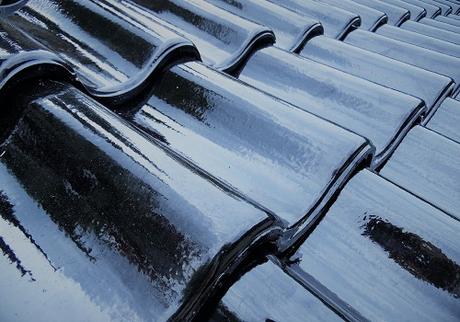After a strenuous and exhausting day of work, the last thing you want to see when you plunk down on the couch for some evening relaxation is a stained ceiling. The unpleasant discoloration appears to be a watermark and after the last few weeks of stormy weather, you’re worried it may be the product of a roof leak. The latest episode of American Horror Story is quickly approaching and you’d like to do some quick investigation before you hunker down for the night. Here are some tips surrounding how you can detect a roof leak.
Detective Work
Grab your sleuthing equipment (a flashlight and sneakers), and pay your attic a visit. If the area hasn’t been fitted with conventional flooring, be sure to exercise caution as you move from joist to joist. With your flashlight in hand, scan the underside of your roof, paying careful attention to any sections that are darker in appearance than the surrounding sheathing.

Dark patches can indicate the presence of moisture and/or mold and often point to the source of origin of the leak. If the area has been exposed for some time, chances are mold has begun to develop, as it tends to thrive in high-moisture environments.
Foreign Intrusion
Perhaps a simpler element to detect is a roof leak that’s triggered by the introduction of a foreign object. The object can be almost anything – from a nail that’s somehow nuzzled its way through your shingles to accumulated leaves and debris that have weakened your roof over time due to the heavyweight. If no objects are easily discernible upon first glance, try examining roof vents, which can be found near gable ends or ridges if present. Natural wear and tear can sometimes result in the gradual deterioration of the material used to seal the vents, giving rainwater the opportunity to bleed through weak points.
Leverage Your Insulation
It’s quite common to see insulated attics, which means your roof’s underside may be shrouded in foam material. This layer of insulation can actually aid in your investigative efforts as it is known for decaying much more rapidly and noticeably than wood. Any visible sign of damage on the insulation is a quick indication that the leak resides behind it. Keep in mind that the actual origin point of the leak may be a few feet away from where you see damages manifesting on the insulation. Once you’re clothed in attire appropriate for handling insulation, delicately extract the insulation from the area where it’s impaired, following the trail of water damage until you locate the entry point.
Simulate Rainy Weather
Whether your city is in the midst of a dry spell, or you simply need to recreate some wet weather to help pinpoint the source of the leak, you can mimic rainy conditions by following these steps. With the assistance of a friend or family member, one of you will be required to climb up to the exterior of the roof, while the other stays inside the attic. The outdoor accomplice will be responsible for hosing down the roof, concentrating on small increments at a time so that their indoor companion can inspect the underside of the roof for visible signs of water. Staging a miniature version of rainy weather will allow you to uncover firsthand where your roof is failing to keep out water.
Repairing your leak is not an area of household maintenance to procrastinate – it will only worsen as the days continue to pass. Whether the leak is from a missing shingle and only requires minor mending or it is more extensive in nature, you should contact your local roofing professional to assess the damage and make sure there are no additional areas that require attention.
